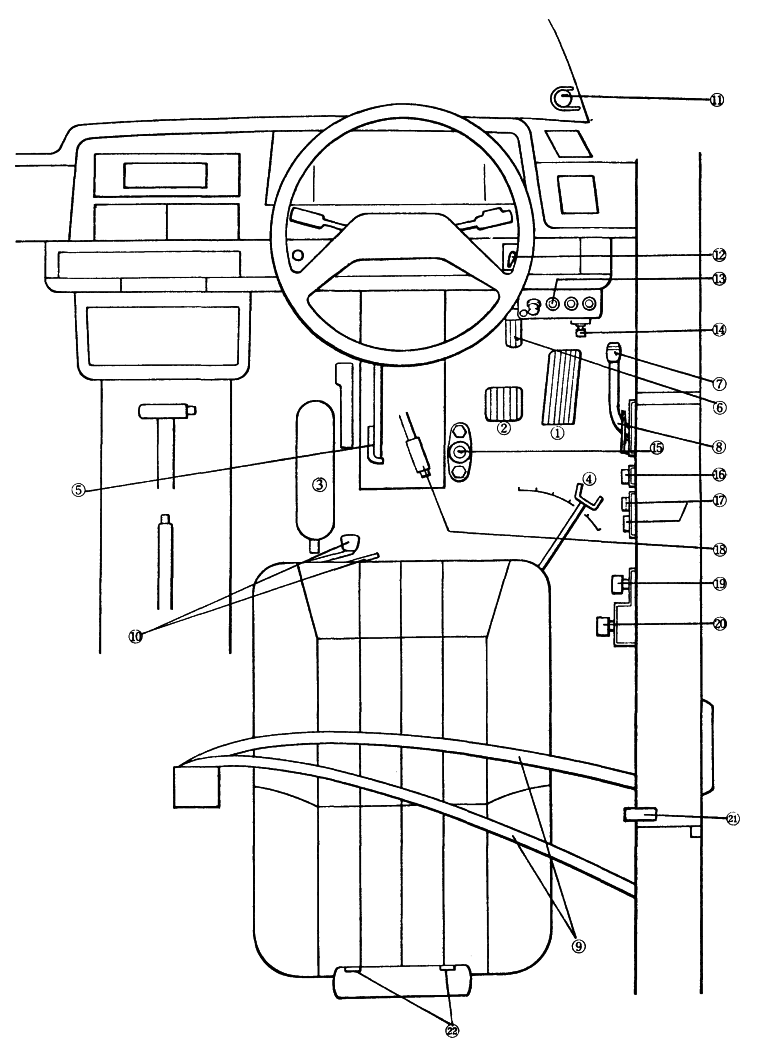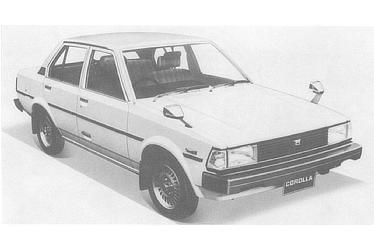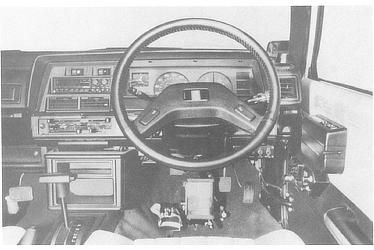Dec. 03, 1982
TOYOTA MARKETS PASSENGER CAR FOR DRIVERS
WITH HAND OR ARM HANDICAPS
Corolla "Friendmatic II" First in Japan
TOYOTA MOTOR CORPORATION today put on sale the Corolla "Friendmatic II," the first car in Japan designed specifically for drivers with hand or arm handicaps.
The Corolla Friendmatic II is based on the popular Corolla Sedan (1500 GL, with automatic transmission), a high-quality, easy-to-drive model redesigned for driving by Thalidomide victims and others with upper extremity handicaps. Use of hands is not required; the driver steers with his left leg and shifts the automatic transmission with his right leg.
Approximately 28,000 Japanese have upper extremity handicaps, including about 300 who are Thalidomide victims. Until recently, legal restrictions prevented the more seriously handicapped from getting a driving license, and there was no Japanese car they could drive anyway. There seemed little chance for them to gain the mobility an automobile offers.
Since the International Year of Disabled persons in 1981, however, interest has increased sharply in encouraging the handicapped to play more direct social roles, including driving their own cars.
To provide the legal support, the Japanese government in July 1982 revised the Road Traffic Act to enable the handicapped to obtain a driving license.

COROLLA FRIENDMATIC II
- Note
- The models described in this release are available only in Japan.
In response to that increased interest, and at the request of Ishizue―a welfare organization established for Thalidomide victims―Toyota organized a special task force to develop a passenger car specifically designed for driving by those with hand or arm handicaps. Miss Kozue Yoshimori, a Thalidomide victim, played an especially key role as Toyota's team worked to develop the vehicle. The result of these efforts is the Corolla Friendmatic II, a high-quality passenger car superior in driveability, safety, reliability and serviceability characteristics. The prototype car Toyota introduced late last year for drivers with upper extremity handicaps attracted much attention, and Toyota received a great many inquiries from the handicapped and others concerning it. That interest encouraged Toyota to push forward even more enthusiastically in its development, and the decision was also made to market the Corolla Friendmatic II through regular sales channels. The new model will provide greater mobility for handicapped persons to drive on their own.
Besides the Corolla Friendmatic II for drivers with upper extremity handicaps, Toyota has already marketed special Corolla, Sprinter, Corona, Carina and Cresta models, one type with dual accelerator pedals and another made to Friendmatic specifications for drivers with lower extremity handicaps. Also available are "Handycab" versions of the Hi-Ace and Lite-Ace, equipped with a lift for drivers confined to wheelchairs. These special vehicles from the Toyota factories will contribute significantly to increasing the mobility of handicapped drivers. The following are the principal features of the Corolla Friendmatic II:

DRIVER'S AREA IN "COROLLA FRIENDMATIC II"
- Boarding and starting
- Besides the usual door handle, a hook-type outside handle is installed about 45cm above the ground on the driver's side of the car to open the door with the foot.
- Levers located at the front of the seat control seat forward/ backward positioning and seat back reclining.
- A control lever attached to the ignition key allows the driver to operate the key by his knee. There is also a starter switch on the floor.
- Driving operations
- Crank-type steering is used, and the driver turns the pedal with his left foot. Power steering makes foot driving much less tiring.
- For shifting the automatic transmission, the driver uses the heel of his right foot to push the select lever located slightly to the right of and below the front seat.
- A pedal-type parking brake is used. Also, an auxiliary brake operated by the left knee allows braking on inclines, when the driver must release the foot brake pedal.
- Turn signals are built into the headrest. The driver operates the turn signals with pressure from the back of his head.
- A horn switch, passing switch and power window switch are installed along the door trim to allow the driver to operate them with his right knee or leg.
- To reduce the burden of driving, a number of items have been made standard equipment, including a remote-controlled rearview mirror, power windows, a trunk opener and a fuel lid opener. Optional equipment includes: an automatic air conditioner, an electronic multi-tuning AM/FM radio and an electromagnetic door lock.
- A triangular warning reflector is attached to the inside back of the trunk lid. The lid is left up when in distress to alert oncoming vehicles.
- Safety
- A three-point automatic seatbelt fastens automatically when the driver is seated and closes the door. The seat is especially designed to hold the driver in position.
- "Run flat" tires allow driving even with punctured tires, at speeds under 60km/h for a distance of about 100km.
- A light sensor automatically turns the headlights on or off according to the brightness level outside the car.
- Others
- Just as other drivers do, the handicapped driver must go to driving school for training prior to taking the test needed to obtain a license. The driver with upper extremity handicaps, however, must take a car specially designed for such persons to the driving school. The Corolla Friendmatic II, therefore, is equipped with an extra auxiliary brake installed for the driving teacher.
- This same car, incidentally, can also be operated by non-handicapped drivers. A switch allows the handicap function to be turned off for regular driving.
COROLLA FRIENDMATIC II INTERIOR ARRANGEMENT

- Accelerator pedal
- Brake pedal
- Crank-type steering
- Select lever
- Auxiliary knee brake
- Parking brake pedal
- Lever for closing door
- Lever for opening door (inside)
- 3-point automatic seatbelt
- Seat adjuster lever
- Automatic light control sensor
- Remote control mirror switch
- Main switch
- Starter
- Dimmer
- Electromagnetic door lock (optional)
- Power window switch
- Wiper/washer switch
- Horn switch
- Passing switch
- Door lock button
- Turn signal switches






